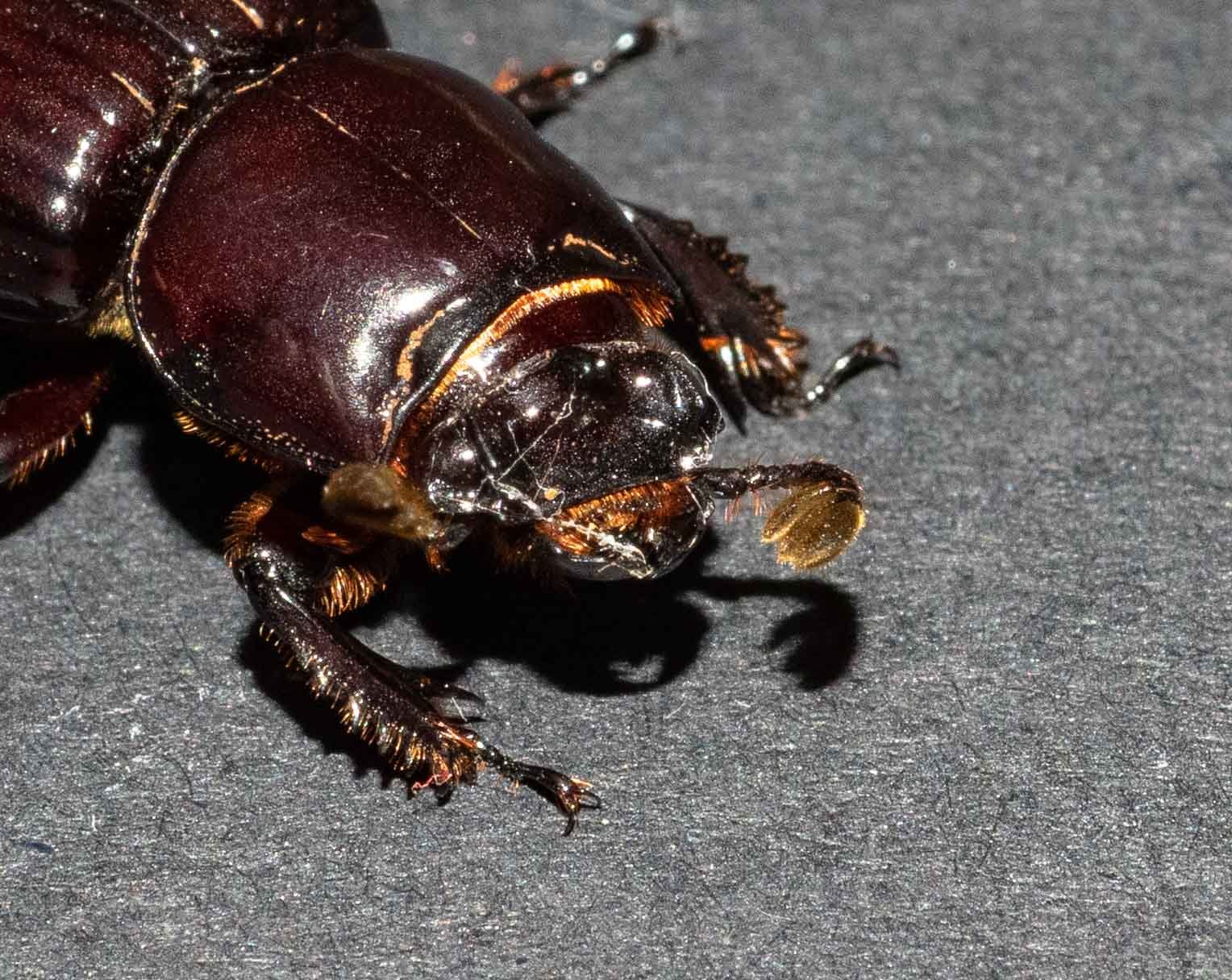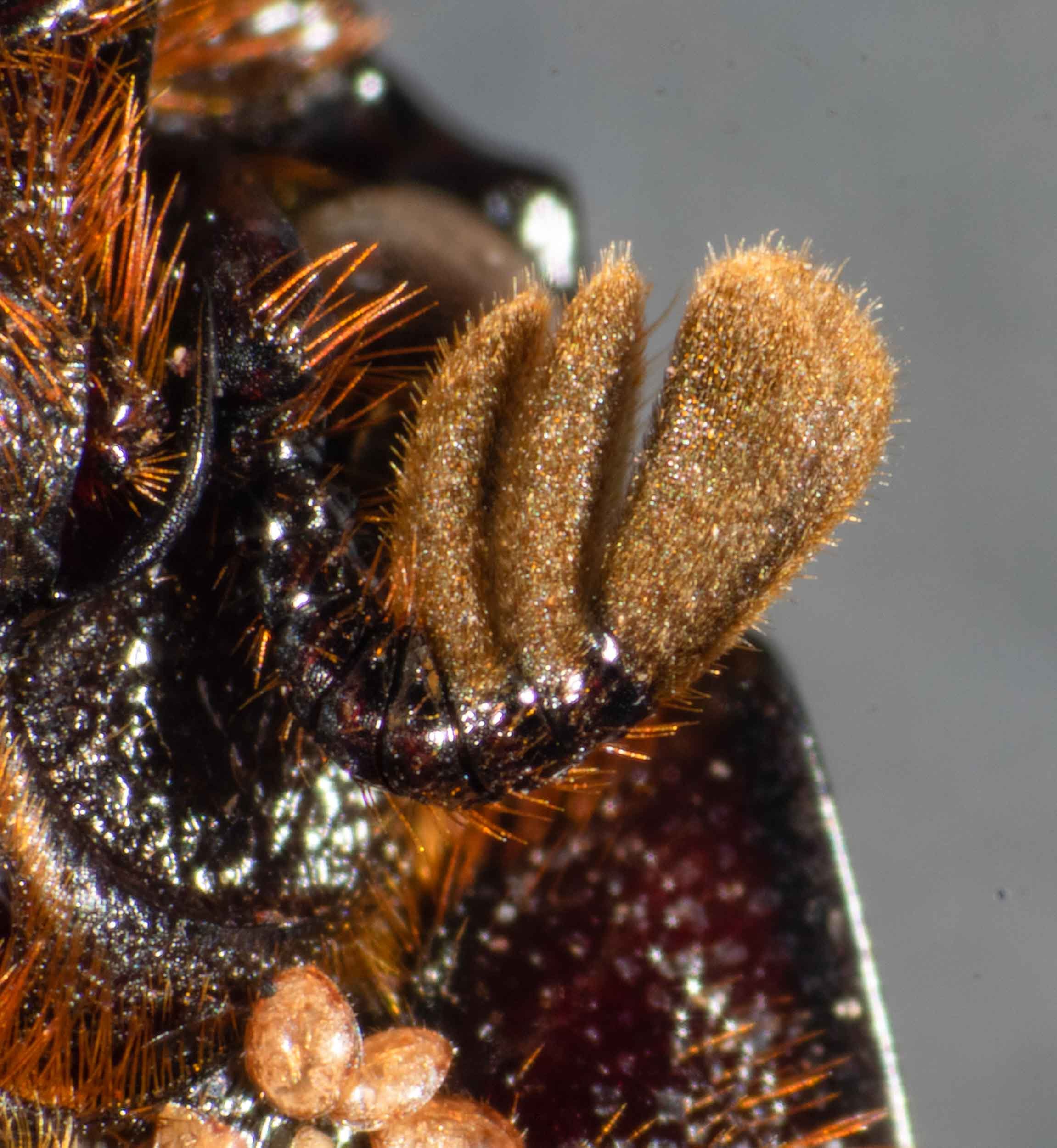Passalidae - another one?

Workbook
On 2nd December 2021 we found a passalid beetle wandering at night, not far from our moth light sheet. A quick look suggested it was different to the 3 species we’ve previously recorded here. Although superficially similar to Aulacocyclus edentulus, the central tubercle is much shorter and straighter. It is also quite a small passalid, at just 25mm total length (labrum to tip of elytra).
I started off calling it Species 4, following on from the three species described in an earlier blog.
But after several days stepping through Dibb’s key, and taking images of ‘Species 4’, I concluded that it was simply a smaller and rather worn specimen of Aulacocyclus edentulus. The major difference that I had first noticed was in the central tubercle … the groove was not very evident and the tubercle itself did not seem to extend as far forward.
Species 4, live shots taken on 2nd December, 2021
Step 1: which subfamily?
One of the most distinctive features of this beetle is the wide, smooth head. There are no inner or outer tubercles, and no parietal frontal carinae (Fig. 1). According to Dibb (1938), this unambiguously places it in Aulacocyclinae.
Further support is seen ventrally … the coxae of the first legs extend to the midline and obscure the prosternum (Fig. 2). The keel is visible anteriorly, but there is little or no gap between the coxae.
Step 2: which species?
Working through Dibb’s key for the genus Aulacocyclus:
Not A. macleayi …. morphologically, I rule out this species with some reservation (see notes below). However, even Dibb notes that “it is doubtful whether A macleayi has been recognised since it was described” and there are no records referred to this species among the 230+ museum records for Aulacocyclis listed on ALA.
Back to the morphological features:
I’m not convinced that the supra-orbital carinae are “united posteriorly across the vertex”. There is a shallow ridge at the back of the head area, but this is really just the base of the central tubercle (by my interpretation). The supra-orbitals appear quite distinct (see Fig. 1b)
A second feature in Dibb’s key is “anterior tibiae broad”. They are quite broad, so I compared them to A. edentulus … there is no difference (Fig. 3). Dibb doesn’t mention the tibiae in the description of A. edentulus, so I assume these are not unusually wide.
Not A. teres.
At 25mm in length, Species 4 is too small.
A. teres is 35-40mm.
In addition, the lateral areas of the metasternum are narrow (Fig. 4).
In A. teres they are “very broad”.
Figure 4: ventral view, live animal (Species 4)
Not A. deyrollei.
The central tubercle is not depressed, and viewed from above it does not “form a wide U-shaped carina”. Nor are the supra-orbital carinae “somewhat depressed” (see Fig. 1). Note that I am interpreting depressed as meaning that the base of the carinae are lower than the general level of the head.
Not A. gravelyi.
The shape of the central tubercle rules this out. In particular, the anterior face “almost vertical from the anterior margin of head to apex of central tubercle”. Rather, it arises close to the midpoint of the head (Fig. 5).
Figure 5: head, dorsal (Species 4)
At this point in the key things got confusing.
It all came down to the dorsal groove on the central tubercle. The groove in Species 4 was so indistinct (Fig. 6a) that at first I considered it '“obsolete”, which led me to look closely at A. rosenbergi as a candidate. But several features didn’t fit, including the antennal lamellae (Fig. 7b) (“long and slender” in A. rosenbergi) and lateral metasternum (Fig. 8)(“almost smooth” in A. rosenbergi).
Eventually I concluded that the only difference between Species 4 and my specimen of A. edentulus was indeed the central tubercle … and that this could well be due to wear.
Importantly, Dibb includes the following words of warning:
“Some specimens can be classed as ‘old’ at a glance, due to the appearance of the cephalic ridges and tubercles which have been ground down through wear. This feature must not be overlooked when using processes for differentiation purposes.” (Dibb, 1938. p.105)
I had indeed fallen into the trap of overlooking them!
Below are the various images I compiled before I came to the realisation that I was looking at wear-and-tear.
Figure 9: Species 4
But what if I’m wrong? What if it’s not worn at all? Indeed, in many ways the animal looks in fine condition. The antennae are glossy, the anterior edge of the head and mandibles look in good condition.
If it’s not A. edulentus, and if the central tubercle morphology is ‘real’, then it’s a good match for A. rosenbergi. I note, however, that there are no records in ALA referred to A. rosenbergi. Or A. rosenbergii
Update: I put the sighting up on iNaturalist and Owen Seeman kindly responded … turns out that it’s not simply worn, so it’s not A. edentulus. It may be A. aliicornis …. but the jury is still out. More info coming soon :)
References
Dibb, J.R. 1938. Synopsis of Australian Passalidae (Coleoptera). Ecological Entomology, 87(4), pp 103-124 (available from Wiley Online)
This is a workbook page … a part of our website where we record the observations and references used in making species identifications. The notes will not necessarily be complete. They are a record for our own use, but we are happy to share this information with others.





















